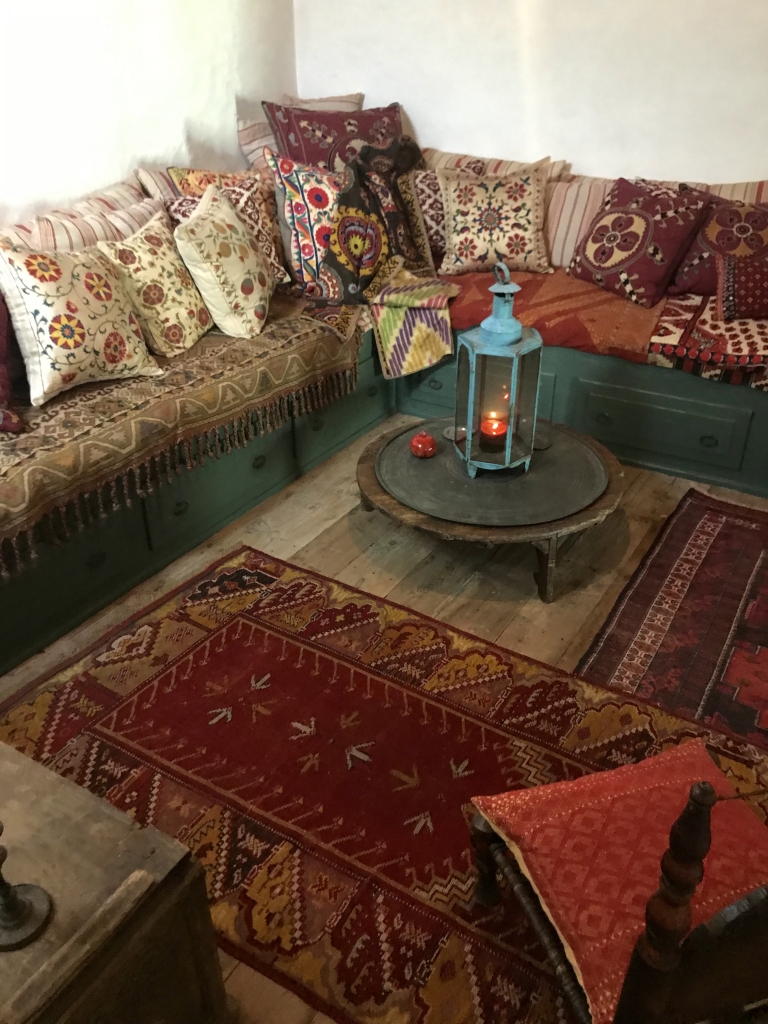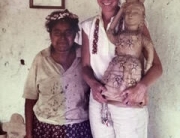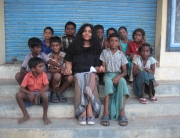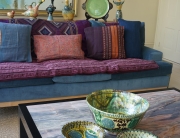
Being of Greek descent, I always had a taste for the exotic, and a passion for ancient cultures and antiquities. Grandmothers created handmade lace, and embroidered, and crocheted, in traditions they brought over from the “old “ country, having left the Peloponnesus around 1915. This early exposure to Folk art, and the memory of the stories that accompanied textiles, pillows and coverlets, remained in my subconscious for decades.
As a fashion designer, I had always been obsessed with fabric history and innovation, layered textures and the richness of embroideries. I studied at the Parsons School of Design in the late ‘70’s, a time of great appreciation for historic references in fashion, interiors and textiles. It was just after Saint Laurent’s Russian Peasant Collection, and the emergence of Mary McFadden, with her African inspired prints and her Imari pleats, that I fell in love with Jack Lenor Larsen’s hand woven upholstery fabrics and through his work, was exposed to ikat and batik techniques. Throughout my professional career, and as Creative Director of Cerruti, in Paris, and Donna Karan New York, I had the privilege of working with exceptional historic fabric mills in Italy, France, and Japan, and legendary embroidery houses in France and India. My work has been enriched by research and exploration into distant artistic cultures.
Acquiring and restoring a house on the Greek island of Patmos in the early 2000’s provided the opportunity to live with much of the folk art I had dreamt of. Patmos is a unique island in the Dodecanese, having enjoyed special privileges whilst under Ottoman rule, and has been occupied by the Venetians, the Russians and into the early twentieth century, by the Italians. It was home to wealthy sea captains of the 18th and 19th centuries, in the cross roads of trade routes from Egypt, Turkey and the Levant. Their homes were resplendent with eclectic layers of textiles, embroideries, ceramics, and furniture, collected from other places, and combined with treasures from local Greek islands, with their strong traditions in embroidery, weaving and clay.
The style of the “The Turkish room,” in the mid 19th century house in the village of Chora, reflects the combination of objects I like to believe possess secret histories. A collection of pieces old and new layer like ancient cultures over one another, reflecting the Ottoman continuum. A cerulean blue Turkish lantern is placed on an 18th century copper tray from Iran, on a wood sofraz from Mytilini. On the banquette are various textiles from India, Turkey and Victorian England. Pillows from the International Folk Art Market— Bukharan suzani embroidered by Zarina Kenjaeva of Uzbekistan, and those from Turkey’s Mehmet Cetinkaya Gallery, embroidered in the Armenian tradition, mingle with pillows I found at a craft market in Ranthambore, India, and some I had made from an antique embroidered Tashkent suzani. Behind these are cushions I had made from French ticking stripes woven between the Wars, that I gathered from the Marche aux Puces in Paris. The piece de resistance is a coat tossed in the corner, in Shakhrisabz embroidery—the entire surface is embroidered in a rare centuries old tradition revived by Gulnora Odilova, of Uzbekistan, that I dreamed about year after year at the Folk Art Market. It is reversible to a marvelous handwoven silk ikat pattern. The carpets on the floor were found thirty years ago at the Grand Bazaar in Istanbul. And on the nomadic chair from Afghanistan in the foreground sits a pillow by Pedro Meza, a brocade woven on a backstrap-loom with an historic Mayan design, from Mexico. Pedro Meza’s works, which I have acquired year after year at the Folk Art Market, weave through many rooms, because the patterns, and their sensitive colorations, often resemble those found in the rare embroideries of the Dodecanese islands, especially those from Rhodes.
Each piece of Folk Art tells a story, and this room is abuzz with centuries of anecdotes. Embedded within the cloths are inherited family traditions, cultural superstitions, the status of dowries presented and passed down, personal histories. The patterns, historically possessed with magic forces and protections, speak of interpretations of nature and the cosmos, as they spoke to Alexander the Great and Genghis Khan, Byzantium and the Ottoman culture. Their beauty is as unique today as ever, and they excite with energy. Each stitch echoes a vibration, the artist’s passion to create a personal yet universal design language. Thanks to the Folk Artists, these traditions have been preserved and interpreted, to form works of living art, for us to enjoy and for future generations to be inspired by.
****
Peter Speliopoulos, the founder of Peter Speliopoulos Projects, is a multidisciplinary artist creating ceramics, and home objects. His foundation as a fashion designer, creative director, and designer of costumes for opera and modern ballet has influenced his work. He was most recently the Senior Vice President of Design and Creative Director of Donna Karan New York, and former Creative Director of Cerruti Arte, Paris, and has designed for leading international fashion houses in France, Italy, and New York, for over 30 years. Peter has also designed costumes for numerous internationally performed operas and ballets in collaboration with choreographer/director Karole Armitage. He is a native of Springfield, Massachusetts, and received his B.F.A. from the Parsons School of Design in 1982. He is a member of the Council of Fashion Designers of America, and serves on the board of Armitage Gone!





